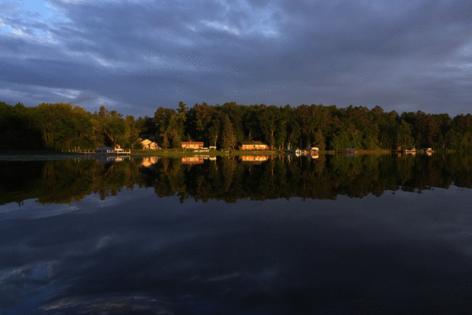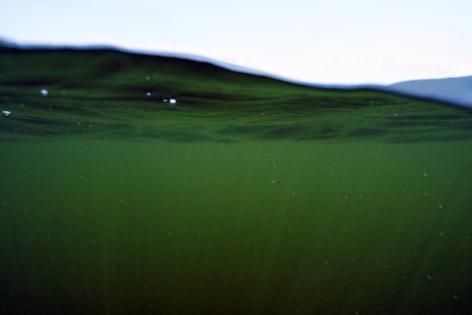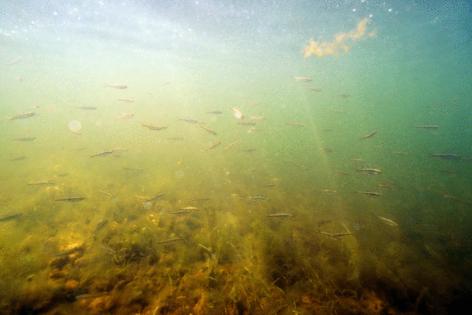This lake can lay claim to the title of fishiest in Minnesota
Published in Outdoors
MINNEAPOLIS — In the far north of Crow Wing County, about 30 miles beyond Brainerd, there’s a heart-shaped lake that locals don’t want anyone else to know about.
A stony brook runs through it, pouring in from the northwest shore and exiting over gentle rapids on the southeast, where the water is so clear that one could count the pebbles on the bottom, and the sleek bass guarding their nests, and the schools of minnows swarming, darting and feeding in the shallows.
Mitchell Lake in the town of Fifty Lakes may be the best place in Minnesota to be a fish.
The lake is mostly overlooked by anglers and boaters; its larger neighboring lakes are the ones that have made the greater Brainerd area a destination. But by one metric, Mitchell has every other lake in the state beat. Judging by the health of the fish, Mitchell isn’t just excellent or outstanding, it is perfect.
“It’s incredible,” said Jessica Massure, a research scientist for the Minnesota Department of Natural Resources. “Mitchell Lake is a pretty special spot, really.”
Its score is a testament to both the unique geography around Mitchell and the smart, modest development of the cabin and landowners on its shore.
The DNR started issuing grades and scores to about 3,000 lakes in 2023 to help residents learn about their condition. The grades, for the first time, give residents and local governments an easy to way to look up the status of their lake and compare it to others without needing to scour through reams of pollution data. A searchable database of every lake with a grade was built by the DNR’s Watershed Health Assessment Framework program.
The letter grade, from A+ to F — based on a 0 to 100 score — denotes the health of a lake and how far it has fallen from what a lake of its size, depth and region should be. A lake’s score is based on how polluted it is, whether fish and native plants survive, and the development on its shoreline and watershed.
There are 11,842 lakes in Minnesota, many of which are too remote or small to have been consistently studied. Biologists scored every lake with enough data, which tended to be the biggest and most popular. Lake Superior, Lake of the Woods and other border lakes were omitted.
The handful of Minnesota lakes that received the best grades and scores in the high 90s are still almost natural, with very little pollution or marks of human intrusion.
Overall, Mitchell received a B, which is an average score for lakes in its area. But the lake excelled in the fish health component of the score. Mitchell is the only lake to receive a score of 100 for its fish. Only 13 other lakes in the state even made it to 90.
That’s not the same as a great fishing lake. That score means that the aquatic life in Mitchell Lake is as biodiverse as it should be. The lake harbors as many kinds of fish, including species like the pugnose shiner minnow that have become very rare and threatened, that a deep lake in central Minnesota would have been expected to have before human development.
The lake is both a deep water refuge for cisco, a ghostly whitefish that lives in the coldest water it can find, and a shallow sanctuary for the small darters and shiners that never leave the shore. No invasive species — plant or animal — have ever been found in its waters. Large swaths of its shoreline and the surrounding lands have been left wooded and natural.
A lake’s fish score is officially called the index of biological integrity, or IBI. When Massure talks about the IBI, she starts by warning that a good score does not necessarily mean good fishing. Some of the lakes that produce excellent walleye or northern pike fishing have fairly low IBI scores, she said.
That’s because game fish are generally tough and can survive in degraded conditions that wipe out other species.
What the index does measure is the variety, size and overall health of species that are able to survive in a lake. Researchers give extra weight to sensitive fish, which are usually the first killed off by pollution, shoreline development or, increasingly, warmer water.
One of the reasons Mitchell Lake is special is that stony brook that feeds it, Massure said.
Daggett Brook winds through 6 miles of uninterrupted woods, marsh and bog before it empties into Mitchell Lake. That stream offers untold schools of minnows a slow-moving and relatively safe place to forage for insects and breed.
The pugnose shiner, for example, has been on the state’s threatened species list for decades and is now only found in very few lakes in the state. It’s a golden straw-colored fish with a single black stripe along its side and is usually one of the first species eliminated from a lake when people build docks and cabins. The fish can only survive in lakes that are connected to streams. It also needs clear water and a great deal of vegetation right along the shore.
Problems for the shiner and other species like it usually start when a lakeshore has more than 16 docks per mile, Massure said.
Mitchell Lake is just below that threshold.
Researchers last surveyed the lake in summer 2020. Deep lakes with many bays like Mitchell are generally considered excellent if they’re home to 28 native species of fish. Surveyors found 35 kinds of fish in Mitchell and 26 species of aquatic plants.
“That’s a very diverse lake,” Massure said.
The lake has one public boat launch on its northern end with a small dock, where bullfrogs and painted turtles rest among lily pads. The shadows of large pike move among tall weeds just under the surface. Farther out, two loons swim together heading nowhere in particular.
It takes a canoe about 20 minutes of easy paddling to reach the center of the lake, which covers a little more than 400 acres.
From there, nearly all of the private docks along the shore are visible. Most of them have a pontoon boat or small fishing boat alongside. Hardly any of the cabins or houses to which those docks belong are visible from the water. The cabins on Mitchell Lake tend to be hidden under tall pines and thick hardwoods.
For more than 100 years, those trees have been one of the lake’s selling points. As far back as 1902, real estate ads in Minneapolis newspapers mentioned “the timber and fine hunting of all kinds” surrounding Mitchell Lake. In 1928, a camper wrote about sleeping under “a large grove of white timber” near the shore, where he cut fir and balsam boughs to make a bed and woke up under 5 inches of snow.
Some of those very same firs and pines may still be standing on Mitchell’s shore, where they provide an all-important buffer, keeping pollutants and sediment out of the lake and the shoreline natural for nesting birds and needed insects.
That same trend is generally true among most lakes on the northern edge of the county, said Melissa Barrick, the district manager of the Crow Wing Soil and Water Conservation District.
“Typically, in that area you still have a little bit of smaller homes and less of that near-shore development than you’ll have in some of the bigger recreational areas closer to Brainerd,” she said.
More than 95% of the lake’s watershed is undeveloped. Immediately to the north of Mitchell is hundreds of acres of county-managed forests and wetland, most of it tax-forfeited land. Aside from a few hiking trails, those bogs and woods are undisturbed, working as giant filters that slow down rainwater and settle out nutrients, pollutants and sediment, allowing clean water to enter the lake.
Mitchell Lake doesn’t get a perfect score in all respects.
The water had too much phosphorus and was too cloudy to earn an A. That’s likely because a changing climate has brought heavier rainstorms to central Minnesota that wash extra nutrients and sediment into the water. Shorter winters have given algae and certain bacteria a longer growing season.
The Watershed District doesn’t believe it would take much work to bring the lake’s grade up. The district created a plan for Mitchell that calls for installing a handful of small rain-gardens and helping homeowners keep their septic systems from polluting the lake.
On a July day at Mitchell Lake, the wildlife seems to have the upper hand.
From the center of the lake, a storm blows in from the west. The loons don’t seem bothered by the rain, and small fish jump after something on the surface.
Before long, the clouds part for the low and setting sun.
One of the loons calls out, then a bullfrog and a barred owl. The calls echo off the otherwise empty lake, and again the loon, the frog and the owl call out. There is plenty of space and food for them all. The only competition seems to be which of the three would get the day’s last word.
____
©2025 The Minnesota Star Tribune. Visit startribune.com. Distributed by Tribune Content Agency, LLC
















Comments